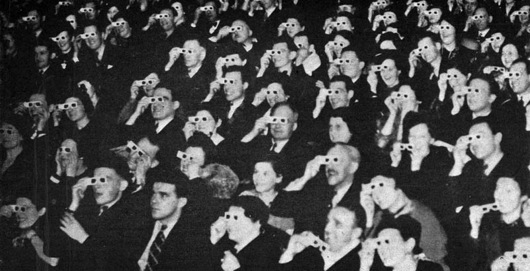
Ok…I like gimmicks as much as the next guy, but i feel like there are some major issues completely overlooked by this Hollywood bandwagon…
Lack of Real Depth
In traditional “2D” films, camera focus was used to create the illusion of depth of field.
For example, Some blurry branches and flowers in the foreground, A crisp sharp romantic couple in the mid-ground, and lovely soft focus sunset in background. We manipulated the depth of field of cameras in order to accentuate the sense of space in the image. This was a good solution to mimic the way in which our eyes focus.
Now in 3D, this trick doesn’t work any-more. As the image is already in 3D there is no need to “fake perspective” by creating blurry back or foreground. Your eyes want to freely wander in this dimension and expect to be able to focus on what they like, but they can’t.
A true 3d film should take into consideration my eye movements and how much my eyes are crossing or not. With this information it should blur dynamically whatever I am not focusing on. This would be a more immersive experience, but even then this technique only adds a little depth using two fixed perspectives.
Does it Enhance the Story?
No. Film-making is all about immersing the audience, making them feel
emotions and journey through perils and joys. You are meant to forget who you are and follow the protagonists through an experience. A 3D movie cheapens this illusion by reminding you that you are in no real danger as a fake arrows zoom past or a set of jaws comes out to gnaw at you, laughable.
What next…
As most movie buffs, I’m not fan of this recent trend to make everything ‘in your face’. However, I am definitely interested in it’s development. For now while 3D in movies has not evolved past a 1950’s curiosity, it is looking very promising for gamers and the whole gaming industry. It will also one day turn into holography, which has the advantage of being able to display hundreds of perspectives, as opposed to the bare minimum of two (for more info on this check this BBC news article). This will really start changing the landscape of media as well as making us question further into the nature of reality.

The problem with 3D media can be seen as more than just immersive 3D displays. To move away from media with 3D gimmicks and instead towards something that seems more real we have to deal with the viewers sense of presence and the scene’s own plausibility (www.cs.ucl.ac.uk/staff/m.slater/Papers/rss-prepublication.pdf).
To properly implement this may be difficult with current film direction styles (change of viewpoint etc) but would be especially difficult with something that requires interaction such as videogames. Perhaps modern film as a whole will spawn a style where 3D works?
Seeming real is only tangentially related to presence. Crayolaland in the CAVE generates much more presence than more photorealistic environments.
Presence researchers as a whole often dismiss games as not generating much presence, but I think this is wrong. People talk naturally about the things ‘they did’ in WoW or some FPS, and it’s well established that agency increases presence, something that games tend to be good at.
But unlike a game, a story or film isn’t really about presence. If anything, it’s about subordinating the viewers sense of presence. While you’re watching a film or reading a book, the illusion is to remove your whole sense of self. If anything, (as Arthur points out with his comment about 3d arrows), the danger of 3d film is that it is more likely to generate presence, which when you’re telling a story is usually exactly what you don’t want. Since you don’t exist in the fictional world of the film, any sense of presence you feel is in fact a breaking of the fourth wall.
I agree, it is really annoying when I can’t focus on something in the foreground, it really takes me out of the movie. That said, I really like 3D for some films. Step Up 3D used 3D particularly effectively. Being such a kinetic film, you got a real feel of the speed and alacrity of the characters and there is one scene in the film where there are clouds of dust coming off the characters hands when they clap them together which is extremely effective. However, as much as I enjoyed the 3D in that film, I definitely don’t want every film to be in 3D until they make it in “True 3D” such that I can focus on any part of the screen I wish.
There’s an excellent article here on how modern film making techniques don’t mix well with 3d, and the requirement to rediscover older techniques like those used in Citizen Kane. I liked this quote:
There’s nothing about RealD (the technique used in cinemas at the moment) that means you can’t have the whole scene in focus. It’s a shame that so many people are equating 3d with bad 3d, and think it’s a limitation of the technology rather than a symptom of the fact that 2d film artists still haven’t got their head around the right way to make 3d film art yet.
I want real holographic 3D too. That’s the next big media breakthrough waiting to happen. 3D on a 2D screen is just a side show that has been tried several times before and just hasn’t taken off.